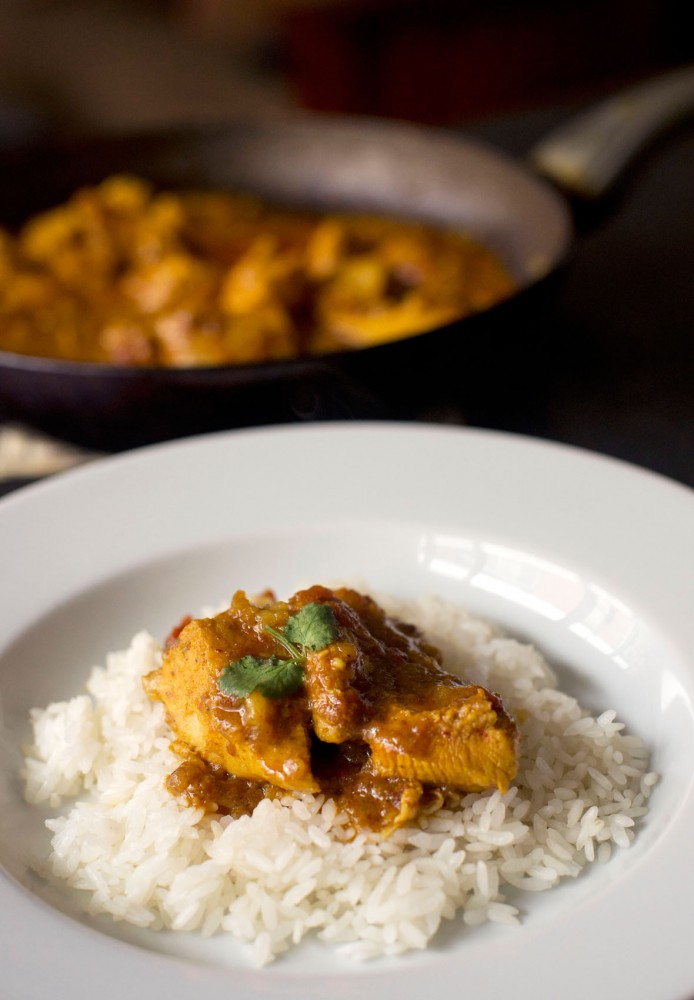Every culture has curry. The term itself is vague, generally meaning a thick, spice-laden sauce. Wherever you are from, though, curry should be a comfort food.
It’s warm. It’s heavy. It’s like stew but you don’t have to mess with any dumb vegetables. It’s food that’ll force you to nap afterward. I can’t imagine anything better for wintertime.
General tips
If you don’t own a food processor, thickening the curry sauce to that perfectly gloopy texture can be tough. You want the sauce to gently coat the meat or veggies.
For best results, simmer the curry for an hour or two. A half cup of unflavored yogurt can also help thicken the sauce. Otherwise, you can go the inauthentic route and mix in some flour.
Any curry recipe you come across is liable to have an enormous list of spices in specific amounts. It’s important to know which of these are essential and which ones are included because the author likes saying the word “cardamom.”
Typically, cumin and coriander make up most of the flavor profile of curries, chili powder calibrates the spiciness and salt bolsters the general flavor.
Other spices like cinnamon, cardamom, star anise, cloves and any others you’ve never heard of usually just add extra pizazz to a curry. If you have them, use them. Otherwise, don’t bother buying an $8 jar of a spice you’ll never use again.
When it comes to chilies, smaller peppers are typically spicier. For curry, I’d recommend using either serrano peppers or Thai bird’s-eye chilies. Both varieties are cheap and pack a lot of spice.
Indian chicken curry
Each region of India has its variations and specializations in curry, so calling one recipe a “basic Indian curry” is a little disingenuous.
This dish, though, is a nice middle ground among the endless varieties of Indian curry. Depending on the state of your pantry, you should be able to whip this up without going too far out of your way at the grocery store.
2 chicken breasts, cut into 1/2 inch cubes
1/2 medium onion, diced
1 tomato, diced
3 cloves garlic, minced
1 green chili, seeded and minced
1/2 inch piece of ginger, peeled and minced
1 tablespoon cumin
1 tablespoon coriander
1 teaspoon black pepper
1 teaspoon turmeric
2 teaspoons chili powder —depending on how spicy you want the curry to be
1/2 teaspoon cinnamon
1/2 teaspoon nutmeg
Salt to taste
Vegetable oil or butter
In a large frying pan, sauté the onions, garlic, ginger and chilies in the oil about six minutes until translucent.
Add the ground spices and salt and thoroughly mix to coat the sautéed mixture.
Mix in enough water to entirely coat the meat. Bring the contents up to a boil, reduce to a simmer then cover until the mixture is sufficiently thick, about an hour. Periodically taste the curry sauce and adjust the spices to your liking.
Serve alongside long grain rice and naan.
Green-ish Thai curry
If you don’t own a food processor, this curry will be more reddish yellow than green. Trust me, though. It’s a green curry.
A little more involved than the Indian chicken curry, you won’t be able to make this Thai alternative with ingredients lying around the house.
Even with the longer prep time, this curry is still simple to cook.
2 boneless, skinless chicken breasts, sliced into strips
1 green bell pepper, sliced into strips
1 red bell pepper, sliced into strips
1 medium onion, diced
1 inch hunk of ginger, peeled and minced
3 cloves garlic, minced
3 green Thai chilies, seeded and minced
1 cup cilantro, minced
2 stalks lemongrass, minced
10 ounces coconut milk
2 tablespoons fish sauce
1 lime, juiced
1/2 tablespoon cumin
1/2 tablespoon coriander
1 teaspoon cracked pepper
Heat the oil in a large frying pan. Sauté half the garlic until fragrant, about one minute. In batches, sauté the chicken until entirely browned. Crowding a pan causes the meat to boil instead of properly fry and brown.
Remove the chicken. In the same pan fry the onion and half the garlic. After about four minutes, add the ginger, chilies, cilantro and lemongrass. Mix thoroughly.
After about a minute, pour in the coconut milk along with the fish sauce, lime juice, cumin, coriander, bell peppers, pepper and cooked chicken.
Let the curry simmer for around 20 minutes. The coconut milk should sufficiently thicken the sauce so extra simmering isn’t necessary.
Serve alongside long grain rice.
Eggplant and tomato curry
So maybe you want the same sleep-inducing heaviness of curry without the meaty aspect. Vegetables like eggplant, potatoes, yams, parsnips and countless others can carry a curry sauce. Here’s just one suggestion for a vegetarian curry.
1 large eggplant, cubed
1 yellow onion, diced
3 cloves garlic, minced
1/2 inch piece of ginger, peeled and minced
1 green chili, seeded and minced
3 tomatoes, diced
1 tablespoon cumin
1 tablespoon coriander
1 teaspoon chili powder
Oil
Salt and pepper
Heat the oil in a large frying pan. Fry the eggplant about five minutes until it’s browned on all sides. Remove the eggplant.
In the same pan, sauté the onion, garlic, ginger and chili pepper for about five minutes.
Add the tomato, cumin and coriander and mix thoroughly. Cover the pan and let simmer for about three minutes. If the mixture begins to dry out, pour in a fourth cup of water and bring back up to a simmer.
Mix the eggplant back in along with salt and pepper. Let simmer and taste the curry, adjusting the seasonings to your liking.
Serve alongside rice or, if you’re feeling particularly wacky, pasta.








